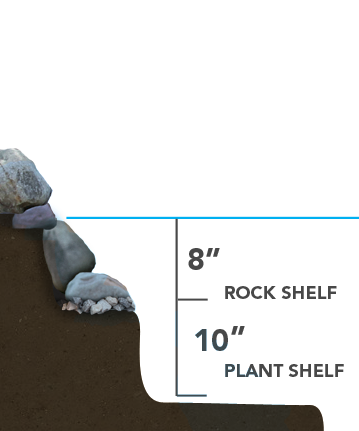Ponds 102 Chapter 7
The Hybrid Pond - RSVP
One way to avoid the disadvantages associated with the Simple Steps method is to make the depth of the initial step into the pond deeper and remove most of the gravel, more like the traditional method of Koi Pond construction, where bare liner that’s easy to keep clean is preferred. These “Hybrid Ponds” combine features from both styles to create safe, lower maintenance ponds that discourage predators and inhibit algae. One such design is the “Rock Shelf, Vertical sides, Plant shelf” (RSVP) profile. Rather than digging the pond straight down or making a series of shallow 6-8” steps that allow waders like raccoons and herons into the pond, the RSVP profile creates an initial vertical step down into the pond about 18” deep onto a flat broad shelf, making it easy for people to get in or out (even little people), but too deep a step for waders like herons, egrets and raccoons, which need more shallow access. (See the College of Biology, Animals section for more info on these common and troublesome fish eaters.)

Here’s how it works: the Rock Shelf referred to in the name supports the coping stones around the edge of the pond about 8” below the waterline, allowing the water level to fluctuate without showing any liner. The Vertical Sides drop straight down from the Rock Shelf another 10” lower to the Plant Shelf at 18” deep, a good depth to set Water Lilies and other aquatic plants, but also providing safe access in and out all the way around. Getting rid of the shallow areas and beaches helps keep the water cooler, eliminating hot spots where algae thrive, and mosquitos have no place to hide from hungry fish. The RSVP profile can be very economical, too, since you can choose to only ‘rock’ the edges and leave the rest of the pond bare liner. Although it might seem that a black rubber liner would be far less attractive than rocks and gravel on the bottom, in practice bare liner ponds tend to look deeper and emphasize the fish more, while being significantly easier to clean. Of course, you can always choose to “Rock-and-Gravel” the whole pond if you desire.

One way to avoid the disadvantages associated with the Simple Steps method is to make the depth of the initial step into the pond deeper and remove most of the gravel, more like the traditional method of Koi Pond construction, where bare liner that’s easy to keep clean is preferred. These “Hybrid Ponds” combine features from both styles to create safe, lower maintenance ponds that discourage predators and inhibit algae. One such design is the “Rock Shelf, Vertical sides, Plant shelf” (RSVP) profile. Rather than digging the pond straight down or making a series of shallow 6-8” steps that allow waders like raccoons and herons into the pond, the RSVP profile creates an initial vertical step down into the pond about 18” deep onto a flat broad shelf, making it easy for people to get in or out (even little people), but too deep a step for waders like herons, egrets and raccoons, which need more shallow access. (See the College of Biology, Animals section for more info on these common and troublesome fish eaters.)

Here’s how it works: the Rock Shelf referred to in the name supports the coping stones around the edge of the pond about 8” below the waterline, allowing the water level to fluctuate without showing any liner. The Vertical Sides drop straight down from the Rock Shelf another 10” lower to the Plant Shelf at 18” deep, a good depth to set Water Lilies and other aquatic plants, but also providing safe access in and out all the way around. Getting rid of the shallow areas and beaches helps keep the water cooler, eliminating hot spots where algae thrive, and mosquitos have no place to hide from hungry fish. The RSVP profile can be very economical, too, since you can choose to only ‘rock’ the edges and leave the rest of the pond bare liner. Although it might seem that a black rubber liner would be far less attractive than rocks and gravel on the bottom, in practice bare liner ponds tend to look deeper and emphasize the fish more, while being significantly easier to clean. Of course, you can always choose to “Rock-and-Gravel” the whole pond if you desire.





